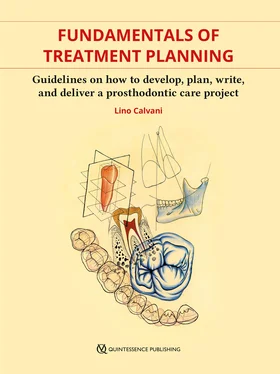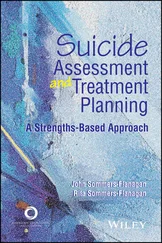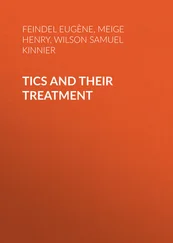In fact, when all anatomical dental reference points are lost, CDs are a precious source of anatomical information and can be used to recover most of these points in any edentulous mouth. In these cases, lip and cheek support, dental esthetics, phonetic and functional landmarks, and all occlusal parameters necessary to properly guide the oral rehabilitation with excellent approximation can be retrieved both in the mouth and on the working casts. This also depends on the knowledge and clinical skills of the clinician and the laboratory technician to replace the lost dentition with final fixed implant-supported prostheses.
Removable overdentures
Indeed, the advent of implants helped to improve this unstable situation. However, if structurally valid roots still remain in strategic positions in the mandible (ie, canines or first premolars), they can be reconstructed and utilized to support, retain, and stabilize any complete denture prosthesis. This possibility is cheaper than the use of implants, and biomechanical improvement can be better achieved by means of fixed attachments, as they may limit the number of biomechanical degrees of freedom to the mobility of the overlying CDs both at rest and during function. Certainly, the choice to save and use the roots is limited by a number of structural and biomechanical parameters that must be carefully evaluated during the first visit and during treatment planning. 71- 82
Mandibular implant overdentures can be obtained with two implants positioned in strategic positions. In these cases, the further use of bars or attachments as a means of anchoring may greatly enhance the stability, retention, and support of these types of prostheses. 83- 94This combination has been defined as optimal and as the standard of care for mandibular CDs. 95- 97
In the maxilla, usually the greater extension and the quality of the bearing surface guarantee better support, stability, and retention. However, in the following instances implants might also be proposed to create maxillary implant overdentures: when the amount of alveolar ridge bone is poor; when the palate is particularly flat and induces instability; when the posterior palatal seal cannot be properly achieved and is not enough to aid the retention; and when the patient is suffering from xerostomia, which induces instability, inflammation, and poor retention of the denture base. 30
Full-arch implant-retained fixed prostheses
These prostheses can be optimal in the restoration of all partial and fully edentulous cases. Limiting factors to this prosthetic choice may be the patient’s chief complaint restrictions, specific negative general health conditions, predictable increased clinical and technical costs, and local limiting factors such as the possible moderate to severe bone conditions that may not withstand further long and complex bone regeneration and implant treatment procedures. 31- 33, 49, 98For more than three decades, this prosthetic tool has become the primary prosthodontic treatment option, offering the best quasi-natural improved restoration of complete edentulous arches with various types of fixed prostheses with the highest degree of success. Certainly, the most important rule for success in implant therapy is the presence of highly qualified and proficient prosthodontists and clinical and laboratory staff who perform all phases of the restoration, from the initial treatment planning phase, in a scientifically correct way. 27, 99- 101This professionalism is an ethical and practical must, because the challenge to plan and create implant prostheses always contains a large number of variables that are not always easy to keep under control unless one is knowledgeable and highly experienced. 31, 102To this end, a description of many limitations and prerequisites for implant choices useful for brainstorming purposes as well as for the practice of treatment planning are reported in Chapter 10.
Bioinformatics and the digital prosthodontics paradigm shift
In the present era of computers, all areas of our lives are constantly becoming more and more digitized. We can only imagine what the reality will look like in 10 years’ time in the medical and dental medical professions as we attempt to grasp day by day just a small part of what thousands of extremely gifted scientists are creating. There are many impressive bioinformatic possibilities at present to store data and exploit in-office computer processing capabilities. Large databases are immediately available on the internet for the easy retrieval of precise information. This is changing the face of the dental medical profession forever, which is true for all dental specialist fields but perhaps more so for prosthodontics. The following section elaborates on a topic that was outlined in Chapter 1and which is continually developing. The recent growth in digital technologies has introduced computer-aided implantology that has allowed for computer-aided prosthetic designing and planning and precise guided implant positioning. 14, 26, 101, 103, 112
Computerized chairside and laboratory technologies
It is possible to craft both analog and digital restorations in an excellent way. Indeed, human endeavor in terms of ‘collective intelligence’ and artistic ability has always been phenomenal. Yet, with the advent and rise of digital technology, this endeavor is rapidly and constantly progressing and improving as a new and broad range of digital dental technologies are increasingly being introduced. This is having an impact on the shape and performance of all areas of the dental medical profession, be it in dental hospitals, universities, dental offices, surgical theaters, operatories, and laboratories. Each day, the diagnostic dental medical devices and other objects and devices in our clinics and laboratories are becoming exponentially ‘smarter.’ This has resulted in a rapid change in our prosthodontic treatment possibilities and ‘tools’, a brief description of which is presented below.
Digital software treatment revolution
The progress in software development and marketing has implications for all areas of dentistry, including prosthodontics. For instance, clinicians today have the ability to access digital algorithms to rationalize workflows, to reduce the time of clinical intervention, to reduce operative costs, and to increase the predictability of results and therefore patient satisfaction.
In the clinic
● 3D high-definition (HD) magnifying visors allow us to see the smallest details that have until very recently been impossible to see even with magnifying lenses (which are today almost obsolete).
● 3D screens allow us to show patients detailed views of the operative field in order to better explain to them the reality of their oral situation.
● Improved multiple detectors in use with cone beam computed tomography (CBCT) are able to take a 3D HD radiographic scanned reproduction of a patient’s head and mouth by simply and quickly sliding only once from one side of the face to the other, dramatically reducing the amount of radiation exposure for the patient.
● Temporomandibular joint (TMJ) occlusal evaluators can tell us precisely what happens in a patient’s TMJs at rest and while speaking, chewing, and biting. Among other things, they provide information regarding invisible occlusal vectors in terms of timing, intensity, and direction of the applied chewing forces. Using precise algorithms, they allow us to study the occlusion during both the treatment planning and in the following clinical phases, according to important static and dynamic parameters now visible and measurable. This was impossible to achieve with the previous analog methods.
● 3D intraoral scanners progressively eliminate the use of trays and impression materials, recording at high magnification all possible details of our preparations and of the surrounding teeth and saving them in both dental imaging and communication in medicine (DICOM) and/or photographic files. This allows for fantastic magnified on-screen reproductions that are ready to be studied for the design and crafting of 3D-printed or milled prostheses.
Читать дальше












